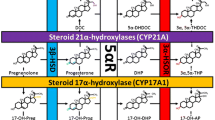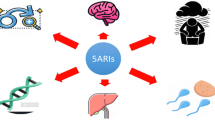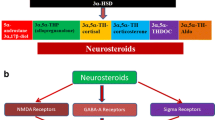Abstract
Purpose of Review
Male pattern hair loss, mediated by dihydrotestosterone, is a common hair loss disorder, affecting over 50% of men over the age of 50. The 5-α reductase inhibitors, finasteride and dutasteride, are Food and Drug Administration-approved drugs for the treatment of this disorder. Several recent studies have reported adverse sexual and spermatogenic events among young men using 5-α reductase inhibitors, such as erectile dysfunction, decreased ejaculate volume, decreased libido, and infertility. In this review, we summarize and analyze the literature regarding the efficacy and safety of these medications, with an overall focus on men’s health.
Recent Findings
Finasteride for the treatment of male pattern hair loss was considered safe according to many previous clinical trials. However, these trials have been recently criticized for inadequate safety reporting. Comprehensive review of the current literature reveals that there is a disproportionately high number of men with 5-α reductase inhibitor-associated sexual dysfunction and infertility.
Summary
Although uncommon, the use of 5-α reductase inhibitors is associated with serious and persistent sexual and reproductive side effects, such as erectile dysfunction, decreased ejaculate volume, decreased libido, and infertility.
Similar content being viewed by others
References
Papers of particular interest, published recently, have been highlighted as: • Of importance •• Of major importance
• Adil A, Godwin M. The effectiveness of treatments for androgenetic alopecia: a systematic review and meta-analysis. J Am Acad Dermatol. 2017;77(1):136–41 e5. This meta-analysis compared finasteride to other treatment options. The mean difference in hair count for men using 1 mg finasteride daily was 18.37 hairs/cm 2 compared to placebo. This difference was superior to low-level laser light therapy (17.66 hairs/cm 2 ) and 2% minoxidil twice daily (8.11 hairs/cm 2 ).
Sultan C, Lumbroso S, Poujol N, Boudon C, Georget V, Terouanne B, et al. Genetics and endocrinology of male sex differentiation: application to molecular study of male pseudohermaphroditism. C R Seances Soc Biol Fil. 1995;189(5):713–40.
• Gupta AK, Carviel J, MacLeod MA, Shear N. Assessing finasteride-associated sexual dysfunction using the FAERS database. J Eur Acad Dermatol Venereol. 2017;31(6):1069–75. The US Food and Drug Administration Adverse Event Reporting System (FAERS) database was assessed for finasteride-associated sexual dysfunction. There was a significant disproportionality in reporting of sexual dysfunction with the use of finasteride was observed whether finasteride was indicated for hair loss (ROR = 138.17, 95% CI 133.13, 143.4) or BPH (ROR = 93.88, 95% CI 84.62, 104.16). When these results were stratified by age, disproportionality was strongest at 31–45 years.
•• Kiguradze T, Temps WH, Yarnold PR, Cashy J, Brannigan RE, Nardone B, et al. Persistent erectile dysfunction in men exposed to the 5alpha-reductase inhibitors, finasteride, or dutasteride. PeerJ. 2017;5:e3020. A retrospective study by Kiguradze et al. found that in a cohort of men exposed to 5α-RIs, the duration of 5a-RI exposure was a more accurate predictor of persistent ED than many known risk factors. Specifically, among men < 43 years old exposed to finasteride 1 mg/day, 34 of 4,284 (0.8%) developed persistent ED, with ED persisting for an average of 4 years. For each 108 young men exposed for > 205 days to 1 mg finasteride, one additional young man experienced PED when compared to those men with shorter exposure.
Irwig MS, Kolukula S. Persistent sexual side effects of finasteride for male pattern hair loss. J Sex Med. 2011;8(6):1747–53.
Kaufman KD, Olsen EA, Whiting D, Savin R, DeVillez R, Bergfeld W, et al. Finasteride in the treatment of men with androgenetic alopecia. Finasteride Male Pattern Hair Loss Study Group. J Am Acad Dermatol. 1998;39(4 Pt 1):578–89.
Gormley GJ, Stoner E, Bruskewitz RC, Imperato-McGinley J, Walsh PC, JD MC, et al. The effect of finasteride in men with benign prostatic hyperplasia. The Finasteride Study Group. N Engl J Med. 1992;327(17):1185–91.
Traish AM, Hassani J, Guay AT, Zitzmann M, Hansen ML. Adverse side effects of 5alpha-reductase inhibitors therapy: persistent diminished libido and erectile dysfunction and depression in a subset of patients. J Sex Med. 2011;8(3):872–84.
Liu KE, Binsaleh S, Lo KC, Jarvi K. Propecia-induced spermatogenic failure: a report of two cases. Fertil Steril. 2008;90(3):849.e17–9.
Chiba K, Yamaguchi K, Li F, Ando M, Fujisawa M. Finasteride-associated male infertility. Fertil Steril. 2011;95(5):1786.e9–1786.e11.
Esteves SC, Glina S. Recovery of spermatogenesis after microsurgical subinguinal varicocele repair in azoospermic men based on testicular histology. Int Braz J Urol. 2005;31(6):541–8.
•• Belknap SM, Aslam I, Kiguradze T, Temps WH, Yarnold PR, Cashy J, et al. Adverse event reporting in clinical trials of finasteride for androgenic alopecia: a meta-analysis. JAMA Dermatol. 2015;151(6):600–6. Finasteride 1 mg daily was considered safe and well tolerated according to 34 clinical trials; however, this meta-analysis of these trials found that adverse event reporting was of poor quality, systematically biased, and not generalizable to routine practice and that most subjects had only 1 year of finasteride exposure.
Chiriaco G, Cauci S, Mazzon G, Trombetta C. An observational retrospective evaluation of 79 young men with long-term adverse effects after use of finasteride against androgenetic alopecia. Andrology. 2016;4(2):245–50.
Hagberg KW, Divan HA, Persson R, Nickel JC, Jick SS. Risk of erectile dysfunction associated with use of 5-alpha reductase inhibitors for benign prostatic hyperplasia or alopecia: population based studies using the Clinical Practice Research Datalink. BMJ. 2016;354:i4823.
Motofei IG, Rowland DL, Baconi DL, Tampa M, Sârbu MI, Păunică S, et al. Androgenetic alopecia; drug safety and therapeutic strategies. Expert Opin Drug Saf. 2018;17(4):407-412. https://doi.org/10.1080/14740338.2018.1430765.
Lolli F, Pallotti F, Rossi A, Fortuna MC, Caro G, Lenzi A, et al. Androgenetic alopecia: a review. Endocrine. 2017;57(1):9–17.
Rossi A, Cantisani C, Scarno M, Trucchia A, Fortuna MC, Calvieri S. Finasteride, 1 mg daily administration on male androgenetic alopecia in different age groups: 10-year follow-up. Dermatol Ther. 2011;24(4):455–61.
Mella JM, Perret MC, Manzotti M, Catalano HN, Guyatt G. Efficacy and safety of finasteride therapy for androgenetic alopecia: a systematic review. Arch Dermatol. 2010;146(10):1141–50.
Amory JK, Wang C, Swerdloff RS, Anawalt BD, Matsumoto AM, Bremner WJ, et al. The effect of 5alpha-reductase inhibition with dutasteride and finasteride on semen parameters and serum hormones in healthy men. J Clin Endocrinol Metab. 2007;92(5):1659–65.
Irwig MS. Persistent sexual and nonsexual adverse effects of finasteride in younger men. Sex Med Rev. 2014;2(1):24–35.
Irwig MS. Persistent sexual side effects of finasteride: could they be permanent? J Sex Med. 2012;9(11):2927–32.
Gisleskog PO, Hermann D, Hammarlund-Udenaes M, Karlsson MO. A model for the turnover of dihydrotestosterone in the presence of the irreversible 5 alpha-reductase inhibitors GI198745 and finasteride. Clin Pharmacol Ther. 1998;64(6):636–47.
Thiboutot D, Harris G, Iles V, Cimis G, Gilliland K, Hagari S. Activity of the type 1 5 alpha-reductase exhibits regional differences in isolated sebaceous glands and whole skin. J Investig Dermatol. 1995;105(2):209–14.
Traish AM, Melcangi RC, Bortolato M, Garcia-Segura LM, Zitzmann M. Adverse effects of 5alpha-reductase inhibitors: what do we know, don’t know, and need to know? Rev Endocr Metab Disord. 2015;16(3):177–98.
Drobnis EZ, Nangia AK. 5alpha-reductase inhibitors (5α-RIs) and male reproduction. Adv Exp Med Biol. 2017;1034:59–61.
Traish AM. Negative impact of testosterone deficiency and 5alpha-reductase inhibitors therapy on metabolic and sexual function in men. Adv Exp Med Biol. 2017;1043:473–526.
Kang HJ, Imperato-McGinley J, Zhu YS, Rosenwaks Z. The effect of 5alpha-reductase-2 deficiency on human fertility. Fertil Steril. 2014;101(2):310–6.
Mantzoros CS, Georgiadis EI, Trichopoulos D. Contribution of dihydrotestosterone to male sexual behaviour. BMJ. 1995;310(6990):1289–91.
Zhang MG, Wang XJ, Shen ZJ, Gao PJ. Long-term oral administration of 5alpha-reductase inhibitor attenuates erectile function by inhibiting autophagy and promoting apoptosis of smooth muscle cells in corpus cavernosum of aged rats. Urology. 2013;82(3):743 e9–15.
Traish AM, Park K, Dhir V, Kim NN, Moreland RB, Goldstein I. Effects of castration and androgen replacement on erectile function in a rabbit model. Endocrinology. 1999;140(4):1861–8.
Roehrborn CG, Boyle P, Nickel JC, Hoefner K, Andriole G, Aria A, et al. Efficacy and safety of a dual inhibitor of 5-alpha-reductase types 1 and 2 (dutasteride) in men with benign prostatic hyperplasia. Urology. 2002;60(3):434–41.
Basaria S, Jasuja R, Huang G, Wharton W, Pan H, Pencina K, et al. Characteristics of men who report persistent sexual symptoms after finasteride use for hair loss. J Clin Endocrinol Metab. 2016;101(12):4669–80.
Samplaski MK, Lo K, Grober E, Jarvi K. Finasteride use in the male infertility population: effects on semen and hormone parameters. Fertil Steril. 2013;100(6):1542–6.
Overstreet JW, Fuh VL, Gould J, Howards SS, Lieber MM, Hellstrom W, et al. Chronic treatment with finasteride daily does not affect spermatogenesis or semen production in young men. J Urol. 1999;162(4):1295–300.
Steers WD. 5alpha-reductase activity in the prostate. Urology. 2001;58(6 Suppl 1):17–24. discussion
Bartsch G, Rittmaster RS, Klocker H. Dihydrotestosterone and the concept of 5alpha-reductase inhibition in human benign prostatic hyperplasia. Eur Urol. 2000;37(4):367–80.
Clark RV, Hermann DJ, Cunningham GR, Wilson TH, Morrill BB, Hobbs S. Marked suppression of dihydrotestosterone in men with benign prostatic hyperplasia by dutasteride, a dual 5alpha-reductase inhibitor. J Clin Endocrinol Metab. 2004;89(5):2179–84.
Erdemir F, Harbin A, Hellstrom WJ. 5-alpha reductase inhibitors and erectile dysfunction: the connection. J Sex Med. 2008;5(12):2917–24.
Nickel JC, Fradet Y, Boake RC, Pommerville PJ, Perreault JP, Afridi SK, et al. Efficacy and safety of finasteride therapy for benign prostatic hyperplasia: results of a 2-year randomized controlled trial (the PROSPECT study). PROscar Safety Plus Efficacy Canadian Two year Study. CMAJ. 1996;155(9):1251–9.
Frankel S. Study of the Food and Drug Administration files on Propecia: dosages, side effects, and recommendations. Arch Dermatol. 1999;135(3):257–8.
Ali AK, Heran BS, Etminan M. Persistent sexual dysfunction and suicidal ideation in young men treated with low-dose finasteride: a pharmacovigilance study. Pharmacotherapy. 2015;35(7):687–95.
Guo M, Heran B, Flannigan R, Kezouh A, Etminan M. Persistent sexual dysfunction with finasteride 1 mg taken for hair loss. Pharmacotherapy. 2016;36(11):1180–4.
Tosti A, Piraccini BM, Soli M. Evaluation of sexual function in subjects taking finasteride for the treatment of androgenetic alopecia. J Eur Acad Dermatol Venereol. 2001;15(5):418–21.
Tosti A, Pazzaglia M, Soli M, Rossi A, Rebora A, Atzori L, et al. Evaluation of sexual function with an international index of erectile function in subjects taking finasteride for androgenetic alopecia. Arch Dermatol. 2004;140(7):857–8.
Fwu CW, Eggers PW, Kirkali Z, McVary KT, Burrows PK, Kusek JW. Change in sexual function in men with lower urinary tract symptoms/benign prostatic hyperplasia associated with long-term treatment with doxazosin, finasteride and combined therapy. J Urol. 2014;191(6):1828–34.
Moinpour CM, Darke AK, Donaldson GW, Thompson IM Jr, Langley C, Ankerst DP, et al. Longitudinal analysis of sexual function reported by men in the Prostate Cancer Prevention Trial. J Natl Cancer Inst. 2007;99(13):1025–35.
Mondaini N, Gontero P, Giubilei G, Lombardi G, Cai T, Gavazzi A, et al. Finasteride 5 mg and sexual side effects: how many of these are related to a nocebo phenomenon? J Sex Med. 2007;4(6):1708–12.
Di Loreto C, La Marra F, Mazzon G, Belgrano E, Trombetta C, Cauci S. Immunohistochemical evaluation of androgen receptor and nerve structure density in human prepuce from patients with persistent sexual side effects after finasteride use for androgenetic alopecia. PLoS One. 2014;9(6):e100237.
Author information
Authors and Affiliations
Corresponding author
Ethics declarations
Conflict of Interest
Mohammed A. Said and Akanksha Mehta each declare no potential conflicts of interest.
Human and Animal Rights and Informed Consent
This article does not contain any studies with human or animal subjects performed by any of the authors.
Additional information
This article is part of the Topical Collection on Men’s Health
Rights and permissions
About this article
Cite this article
Said, M.A., Mehta, A. The Impact of 5α-Reductase Inhibitor Use for Male Pattern Hair Loss on Men’s Health. Curr Urol Rep 19, 65 (2018). https://doi.org/10.1007/s11934-018-0814-z
Published:
DOI: https://doi.org/10.1007/s11934-018-0814-z




